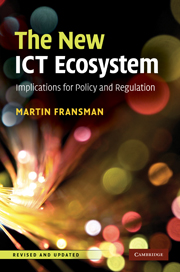Book contents
- Frontmatter
- Contents
- List of exhibits
- Preface
- List of abbreviations and acronyms
- Introduction
- 1 Summary of the argument
- 2 The new ICT ecosystem: architectural structure
- 3 The new ICT ecosystem as an innovation system
- 4 The new ICT ecosystem: a quantitative analysis
- 5 Telecoms regulation
- 6 Policy-making for the new ICT ecosystem
- 7 The way forward: the message to policy-makers and regulators
- Appendixes
- 1 The evolution of the new ICT ecosystem, 1945–2007: how innovation drives the system
- 2 European regulation of electronic communications, 1987–2003
- 3 Some problems with the dominant regulatory paradigm in telecoms (DRPT)
- 4 A short introduction to Schumpeterian evolutionary economics
- 5 Other layer models: OSI and TCP/IP
- 6 Content, applications and services: definitions
- 7 Why do US Internet companies dominate in layer 3?
- 8 How did East Asia (Japan, Korea, Taiwan and China) become so strong in layer 1?
- 9 China's telecoms service providers in layer 2
- 10 Companies in our database, by layer
- Bibliography
- Index
6 - Content, applications and services: definitions
Published online by Cambridge University Press: 04 May 2010
- Frontmatter
- Contents
- List of exhibits
- Preface
- List of abbreviations and acronyms
- Introduction
- 1 Summary of the argument
- 2 The new ICT ecosystem: architectural structure
- 3 The new ICT ecosystem as an innovation system
- 4 The new ICT ecosystem: a quantitative analysis
- 5 Telecoms regulation
- 6 Policy-making for the new ICT ecosystem
- 7 The way forward: the message to policy-makers and regulators
- Appendixes
- 1 The evolution of the new ICT ecosystem, 1945–2007: how innovation drives the system
- 2 European regulation of electronic communications, 1987–2003
- 3 Some problems with the dominant regulatory paradigm in telecoms (DRPT)
- 4 A short introduction to Schumpeterian evolutionary economics
- 5 Other layer models: OSI and TCP/IP
- 6 Content, applications and services: definitions
- 7 Why do US Internet companies dominate in layer 3?
- 8 How did East Asia (Japan, Korea, Taiwan and China) become so strong in layer 1?
- 9 China's telecoms service providers in layer 2
- 10 Companies in our database, by layer
- Bibliography
- Index
Summary
In this appendix definitions are provided for the content, applications and services used frequently in this book.
Content is a commonly used term with regard to the Internet and other electronic media (e.g. television and DVDs). In its broadest sense it refers to material which is of interest to users, such as textual information, images, music and movies.
Applications and services may be defined in the following ways. An application is a program or group of programs designed for end-users. Software can be divided into two general classes; systems software and applications software. Systems software consists of low-level programs that interact with the computer at a very basic level. This includes operating systems, compilers and utilities for managing computer resources.
In contrast, applications software (also called end-user programs) includes database programs, word processors and spreadsheets. Figuratively speaking, applications software sits on top of systems software because it is unable to run without the operating system and system utilities. This is illustrated inexhibit A6.1.
A service is a provider/client interaction that creates and captures value. The following discussion on services comes from an IBM publication available on the Internet.
For instance, almost everyone is familiar with a typical doctor/patient interaction, in which both sides benefit from the transaction – referred to as ‘capturing value’ in services parlance. The doctor receives a fee; the patient gets a health assessment and (it is hoped) recovers from the illness. This basic principle also underlies the work between a services provider and a corporation.
- Type
- Chapter
- Information
- The New ICT EcosystemImplications for Policy and Regulation, pp. 170 - 172Publisher: Cambridge University PressPrint publication year: 2010



